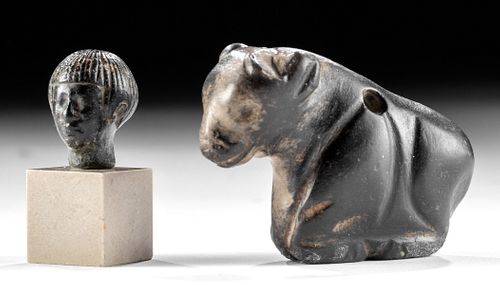Sumerian Chlorite Bull & Egyptian Steatite Head
Lot 66c
About Seller
Artemis Gallery
686 S Taylor Ave, Ste 106
Louisville, CO 80027
United States
Selling antiquities, ancient and ethnographic art online since 1993, Artemis Gallery specializes in Classical Antiquities (Egyptian, Greek, Roman, Near Eastern), Asian, Pre-Columbian, African / Tribal / Oceanographic art. Our extensive inventory includes pottery, stone, metal, wood, glass and textil...Read more
Estimate:
$4,000 - $6,000
Absentee vs Live bid
Two ways to bid:
- Leave a max absentee bid and the platform will bid on your behalf up to your maximum bid during the live auction.
- Bid live during the auction and your bids will be submitted real-time to the auctioneer.
Bid Increments
| Price | Bid Increment |
|---|---|
| $0 | $25 |
| $300 | $50 |
| $1,000 | $100 |
| $2,000 | $250 |
| $5,000 | $500 |
| $10,000 | $1,000 |
| $20,000 | $2,500 |
| $50,000 | $5,000 |
| $100,000 | $10,000 |
| $200,000 | $20,000 |
About Auction
By Artemis Gallery
Feb 13, 2020
Set Reminder
2020-02-13 10:00:00
2020-02-13 10:00:00
America/New_York
Bidsquare
Bidsquare : Exceptional Antiquities, Asian, Ethnographic
https://www.bidsquare.com/auctions/artemis-gallery/exceptional-antiquities-asian-ethnographic-4848
An important one-day auction featuring museum-worthy examples of Egyptian, Greek, Roman, Etruscan, Near Eastern, Far East / Asian, Pre-Columbian, African / Tribal, Oceanic, Native American, Spanish Colonial, Russian, Fossils, Ancient Jewelry, Fine Art, so much more! Artemis Gallery info@artemisgallery.com
An important one-day auction featuring museum-worthy examples of Egyptian, Greek, Roman, Etruscan, Near Eastern, Far East / Asian, Pre-Columbian, African / Tribal, Oceanic, Native American, Spanish Colonial, Russian, Fossils, Ancient Jewelry, Fine Art, so much more! Artemis Gallery info@artemisgallery.com
- Lot Description
Ancient Near East, Mesopotamia, Sumeria, ca. 2500 to 2200 BCE. A lovely black chlorite bull amulet, larger than most of this type, pierced through its back for suspension and featuring a powerful head with large horns. Incised lines give the impression of the animal's limbs, which are curled up against its body as it is portrayed in a seated position. The Sumerians believed strongly in magic, and the magical powers of amulets, created to be deterrents against the Evil Eye. The oldest of these amulets are stone animal form ones like these. The bull was a symbol of fertility and virility. Also, Ancient Egypt, New Kingdom, ca. 1550 to 1070 BCE. A handsome black steatite head of a scribe, carved with simple facial features and a bowl cut that would make a Beatle (John, Paul, Ringo, or George) jealous. This head may be from a shabti, as steatite heads of similar size are (for example one sold at Bonhams, London, on April 13, 2011 (Lot 10) for the equivalent of USD $259,145). Size of largest (bull): 2.3" W x 1.6" H (5.8 cm x 4.1 cm)
Provenance: private East Coast, USA collection, acquired in 2019; ex-Medusa Ancient Art, Montreal, Quebec, Canada; ex-Millea Bros., Ltd. Auction (November 23, 2019, lot 3249); ex-Elizabeth Stafford estate collection, New York, New York, USA; ex-Heidi Volmueller collection, Switzerland, acquired in the 1960s
All items legal to buy/sell under U.S. Statute covering cultural patrimony Code 2600, CHAPTER 14, and are guaranteed to be as described or your money back.
A Certificate of Authenticity will accompany all winning bids.
We ship worldwide and handle all shipping in-house for your convenience.
#152778Bull is in nice condition with light wear commensurate with age and rich deposits. The head is a fragment from a larger piece but is itself in very nice condition with wear commensurate with age, including some smoothing to features but form and most details still in good condition.Condition
- Shipping Info
-
All shipping is handled in-house for your convenience. Your invoice from Artemis Gallery will include shipping calculation instructions. If in doubt, please inquire BEFORE bidding for estimated shipping costs for individual items.
-
- Buyer's Premium



 EUR
EUR CAD
CAD AUD
AUD GBP
GBP MXN
MXN HKD
HKD CNY
CNY MYR
MYR SEK
SEK SGD
SGD CHF
CHF THB
THB















